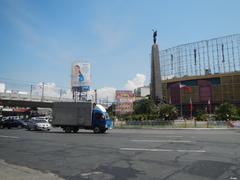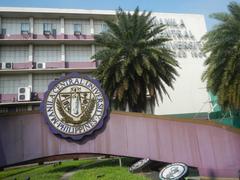
Visiting La Mesa Watershed Reservation: Hours, Tickets, and Travel Tips
Date: 19/07/2024
Introduction
Nestled in the bustling city of Caloocan, Philippines, the La Mesa Watershed Reservation is an ecological jewel and a vital component of Metro Manila’s water supply system. Established in 1929 as part of the Manila Water Supply System, the watershed spans approximately 2,700 hectares and includes the La Mesa Dam, an engineering marvel designed to store and regulate water from the Marikina River (Manila Water). Over the decades, the La Mesa Watershed has evolved from a crucial water source to a symbol of environmental conservation and community involvement. Managed by the Metropolitan Waterworks and Sewerage System (MWSS) in partnership with the ABS-CBN Foundation, the watershed supplies potable water to millions and serves as a haven for nature enthusiasts, hosting various recreational activities and educational programs (ABS-CBN Foundation). This comprehensive guide aims to provide potential visitors with all the information they need to explore the La Mesa Watershed Reservation, from its historical significance to practical travel tips and visitor information.
Table of Contents
- of-la-mesa-watershed-reservation)
- [Early Beginnings](#early-beginningsearly-beginnings)
- [Construction of La Mesa Dam](#construction-of-la-mesa-damconstruction-of-la-mesa-dam)
- [Role During World War II](#role-during-world-war-iirole-during-world-war-ii)
- [Post-War Developments](#post-war-developmentspost-war-developments)
- [Environmental Conservation Efforts](#environmental-conservation-effortsenvironmental-conservation-efforts)
- [Modern Era and Current Significance](#modern-era-and-current-significancemodern-era-and-current-significance)
- information)
- [Tickets and Visiting Hours](#tickets-and-visiting-hourstickets-and-visiting-hours)
- [How to Get There](#how-to-get-therehow-to-get-there)
- [Travel Tips and Nearby Attractions](#travel-tips-and-nearby-attractionstravel-tips-and-nearby-attractions)
- [Accessibility for Differently-Abled Visitors](#accessibility-for-differently-abled-visitorsaccessibility-for-differently-abled-visitors)
- [Special Events, Guided Tours, and Photographic Spots](#special-events-guided-tours-and-photographic-spotsspecial-events-guided-tours-and-photographic-spots)
- and-social-impact)
- and-future-prospects)
History of La Mesa Watershed Reservation
Early Beginnings
The La Mesa Watershed Reservation, located in Caloocan, Philippines, has a rich history that dates back to the early 20th century. Established in 1929 as part of the Manila Water Supply System, it was designed to provide a reliable source of water to the growing population of Manila. The watershed covers approximately 2,700 hectares and includes the La Mesa Dam, which stores and regulates water from the Marikina River.
Construction of La Mesa Dam
The construction of the La Mesa Dam was a significant engineering feat for its time. Completed in 1929, the dam created a reservoir to supply water to the Novaliches Reservoir and subsequently to the Balara Filters, which treated the water before distribution to Manila. The dam is an earth-fill embankment type, standing 24 meters high and stretching 2.5 kilometers in length. The reservoir has a capacity of 50.5 million cubic meters of water (Manila Water).
Role During World War II
During World War II, the La Mesa Watershed played a crucial role in the water supply for Manila. The Japanese occupation forces recognized its strategic importance and took control of the watershed. The dam and its facilities suffered damage during the war, but post-war reconstruction efforts restored its functionality.
Post-War Developments
In the post-war period, the La Mesa Watershed underwent several upgrades and expansions to meet the increasing water demand of Metro Manila. Additional pipelines and pumping stations were constructed, and modern water treatment technologies were introduced to improve water quality.
Environmental Conservation Efforts
By the 1970s, rapid urbanization and industrialization posed significant threats to the La Mesa Watershed. Deforestation, pollution, and encroachment became pressing issues. In response, conservation efforts were initiated to protect and rehabilitate the watershed. The establishment of the La Mesa Nature Reserve in the 1990s marked a significant milestone, aiming to preserve the remaining forest cover and promote biodiversity (ABS-CBN Foundation).
Modern Era and Current Significance
Today, the La Mesa Watershed Reservation remains vital to Metro Manila’s water supply system, providing approximately 1.5 million cubic meters of water per day. Managed by the MWSS in partnership with the ABS-CBN Foundation, it oversees conservation and rehabilitation programs.
Visitor Information
Tickets and Visiting Hours
La Mesa Watershed Reservation is open to the public daily from 6:00 AM to 5:00 PM. Ticket prices are affordable, with discounts available for students, senior citizens, and group bookings. For the latest information, visit the La Mesa Eco Park official website.
How to Get There
The La Mesa Watershed Reservation is accessible by public transportation and private vehicles. From Manila, visitors can take a bus or jeepney to Fairview and then a tricycle to the entrance. Ample parking is available for those driving.
Travel Tips and Nearby Attractions
Wear comfortable clothing and sturdy shoes for hiking. Bring water and snacks. Nearby attractions include the La Mesa Eco Park, which offers additional recreational activities such as fishing, boating, and picnicking.
Accessibility for Differently-Abled Visitors
The La Mesa Watershed Reservation is committed to being accessible to all visitors. Pathways and facilities are designed to accommodate differently-abled individuals.
Special Events, Guided Tours, and Photographic Spots
The watershed hosts various special events, including tree planting activities, environmental workshops, and guided tours. Photographic spots offer stunning views of the reservoir, lush forests, and diverse wildlife.
Cultural and Social Impact
The La Mesa Watershed has become a symbol of environmental stewardship and community involvement. Various educational and outreach programs are conducted to raise awareness about water conservation and environmental protection. The La Mesa Eco Park serves as a recreational and educational facility, offering activities such as hiking, bird watching, and tree planting (La Mesa Eco Park).
Challenges and Future Prospects
Despite ongoing conservation efforts, the La Mesa Watershed faces challenges such as urban encroachment, illegal logging, and pollution. Climate change also poses a significant risk. Continuous monitoring, stricter enforcement of environmental regulations, and community engagement are essential to address these challenges.
FAQs
Q: What are the visiting hours for La Mesa Watershed Reservation?
A: The park is open daily from 6:00 AM to 5:00 PM.
Q: How much are the tickets to enter La Mesa Watershed Reservation?
A: As of 2024, the entrance fee is approximately PHP 50 for adults and PHP 30 for children. Discounts are available for students, senior citizens, and group bookings.
Q: How can I get to La Mesa Watershed Reservation?
A: The watershed is accessible by public transportation and private vehicles. From Manila, take a bus or jeepney to Fairview and then a tricycle to the entrance.
Q: Are there guided tours available?
A: Yes, guided tours are available and provide educational insights into the ecology, conservation efforts, and sustainable practices within the watershed.
Q: Is the park accessible for differently-abled visitors?
A: Yes, the park has facilities and pathways designed to accommodate differently-abled individuals.
References
- Manila Water. (n.d.). https://www.manilawater.com
- ABS-CBN Foundation. (n.d.). https://www.abs-cbnfoundation.com
- Philippine Biodiversity Conservation Foundation. (n.d.). https://www.pbcfi.org.ph
- La Mesa Eco Park. (n.d.). https://www.lamesaecopark.com


